|
|
|
Happy New Year to all readers,
May 2014 - the Year of the Horse - be a great one for you!
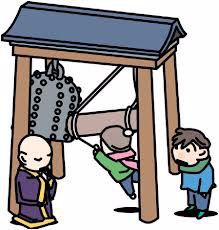 |
|
I live in a city called Kamakura, about an hour South of Tokyo. It became the capital - or at least the de facto military capital - of Japan back in 1192 and remained as such for a scant 160 years or so. But as a result of that period of glory, there are over 300 Buddhist temples scattered across this small city.
Every December 31, they all begin ringing their long, tubular bells with deep tones slowly and prayerfully for a total of 108 reverberating rings - one for each
Bonnno. One cool translation for
Bonno is "blind passions," in other words, the things that can get is into trouble if not kept in check.
As we usually do, my family lined up at the local temple for our turn to swing the rope-suspended log into the long tubular bell and offer a prayer of thanks for 2013, and hope for 2014. The prayers within that hope stretch out to everyone - peace, stability, health, and happiness.
I recall a musician friend of mine, now deceased, who tried to explain the concept of the 108
Bonno to me. She embodied them unabashedly and enjoyably. All 108, I think. Some of them twice a week. They are, she explained, the physical and emotional temptations that keep us from heaven, and cause us suffering on earth.
“But,” she added with an emphatic smile, “without
Bonno, there would be no music!” Nothing has ever rang more true, no pun intended.
I think, too, that without
Bonno, there would be no sake. Kampai to humanhood and
Bonno!
The Sake Professional Course in Japan, to be held January 20 to 24, 2014, has checked in full. The next one will be in the US in the spring, although the exact dates and venue have yet to be announced. Stay tuned!
Any day now, the inaugural edition of the first sake-only English language magazine,
Sake Today, will be released. I will send a special "Exra Extra Read All About It" notice when things are finalized, letting you know where you can get both physical and electronic versions. Readers' support is what will make this puppy fly! Until then, you can follow us via the usual suspects of social media.
If you really want to learn about sake, rather than reading some stodgy newsletter, get to Japan and visit some kura. That is the way to do it! And this coming year offers more opportunities than ever, especially through Sake Tours The trip to Niigata is already full, but the trip to Okayama will be a great one this year! Learn more below.
Happy New Year to all, and please enjoy the newsletter.
John
|
|
Warm Sake in the Days of Olde
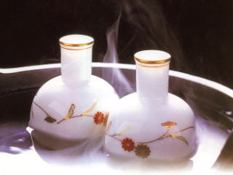 |
|
Today, we enjoy most of our premium sake slightly chilled. I hope that most readers are with me in the acceptance of that general concept. While certainly there are exceptions to this - many of them delicious - it is true that most ginjo sake especially sees its finest aspects highlighted when very slightly chilled down. The reasons for this are hardly rocket science: the delicate flavors and oftentimes fruity aromas that the brewers worked so hard to create are most prominent at these cooler temperatures.
But has it always been like this? Oh, heavens, no. Remember that ginjo sake, and sake made with very highly milled rice, has only been on the market about forty years or so. And the flavor profiles of sake before that were significantly different than they are today.
Does this mean that all sake sucked before the advent of ginjo? No; of course not. But it was different: fuller, richer, at some periods of time a lot sweeter, and often with a significantly higher acidity. And it was, in fact, overall much more suited to warming than modern ginjo types. Actually, that is the real reason we see hot sake all around us in spite of the fact that so many are rightly intoning that premium sake should be served chilled: that is the temperature range at which the flavors and aromas of good ginjo are most easily enjoyed.
An important point is that while it is true that heating can and does cover blemishes in a cheap sake, that is not why they started doing it. No brewer or distributor ever said, “Wow, this stuff is pretty bad. Let’s tell everyone to heat it to get beyond that!” Again, for emphasis:
Sake is not heated to cover faults!
The truth is that sake has been enjoyed warm since long ago, and many producers keep that tradition alive, in a sense. A longer treatise on the roots, rhyme and reason of warming sake stretching back about 1000 years can be found here , for those that are interested.
So in modern times, while we see inexpensive sake being heated all around us, we sit quietly enjoying our premium stuff gently chilled. And I reiterate that there are indeed exceptions: there are premium sake even in the ginjo range out there that have earthier, unique flavor profiles that benefit from a tad of warming.
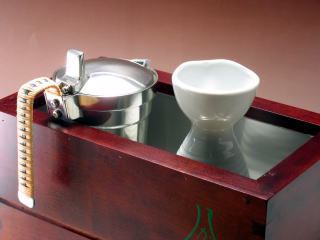 |
|
In fact, perhaps the one thing that has changed in terms of my own preferences for sake is that over the years, I have become increasingly fond of properly warmed, premium sake. Nothing beats it. Nuff said. Notice I did not say hot. Warming sake to lukewarm or slightly warmer temperature will benefit sake with the right flavor profiles. But overheating is another animal altogether. Obviously, nothing can be tasted or sensed when sake is overheated, so avoid extremes of heat.
If one were to wander in to a local pub sixty or more years ago, you would be given a choice of probably one sake: the local one, in but one or two manifestations. You might sit around a square charcoal pit with your companions that evening, and in a remote corner of the pub would be a man whose sole responsibility would be warming the sake for all the customers. Known as the o-kan-ban, he would take orders for sake, sometimes requested at warm, lukewarm, or hot temperatures, and sometimes for just "sake."
He knew his regulars, and how they liked their sake. He would likely have a kettle of hot water into which he would immerse numerous sake flagons called tokkuri, watching and timing them all carefully until each was ready in turn to go to their rightful owner at precisely the temperature requested or preferred.
But we don't see these journeymen any more.
Although it is only peripherally related to the topic at hand, during World War II brewers found their rice understandably rationed, and were forced to cut their product with grain alcohol to further decrease the potential to squander rice. It was an unavoidable situation resulting from the chaos in the world at that time.
Mr. Hideharu Ota, president of the brewery making Daishichi sake in Fukushima, once explained to me, "During the war, naturally, sake consumption and production dropped tremendously. After the war, slowly but surely, sake production returned to its pre-war level. But there was a 20-year gap in sake culture, in the culture of sake enjoyment, and even though sake production and consumption were restored, sake culture never returned to its pre-war levels. That gap was too big to fill."
True, this permanent change in sake culture was aided and abetted by massive changes in society and lifestyle. But whatever the rationale, much was lost culturally. And not the least of these was the almost total disappearance of the o-kan-ban. While I do know of one place in Tokyo that has one (or at least had one, as I have not been there in a couple of years), and I am sure there are others, they are for the most part gone.
Recently I read an interview of an elderly gent that had been an o-kan-ban so many years ago. He described the complexity of his work, and mentioned too a few tricks of the trade.
"If I see I guy come in from the cold," he began, "he might sit down, wipe his nose, and order an atsukan (hot sake). Well, I know his body is chilled, and whatever I send him will seem hotter than it is. So I would serve it a little less hot than usual for him. But I am watching everyone all night. And let's say I see someone glance at his watch and order what he thinks will be one last flagon of warmed sake. I would send it over that table just a tad less warm then he would like it. This would almost always entice him to order one last one to warm him for the road home."
Something tells me that the pub at which this gentleman worked was a fun and profitable place.
|
|
The 24 Grades of Yamada Nishiki
Certainly most readers are aware that rice is not just rice, and that sake rice is better for making sake than regular “table” rice. And surely most readers are also aware that there are various varieties of sake rice, each with its attendant flavors and brewing characteristics. And doubtlessly, most readers know that for lots of reasons, Yamada Nishiki is widely considered the best – even if it is decidedly not the only game in town.
But did you know that not all Yamada Nishiki is created equal, and that there are in fact twenty four different grades of Yamada Nishiki? Well, sort of, anyway…
The “sort of” caveat comes about because not everyone agrees on all aspects of the system that has been set up. On top of that, while there are indeed 24, there is not an absolute hierarchy or order amongst them, as some exist in parallel, and others exist only unofficially.
Let us start with the easy stuff. Rice is usually inspected by the government for quality. The things that are assessed are size, the number of grains with a visible shinpaku (starchy center), the number of cracked grains, the number of undeveloped green grains, and more.
Most rice for eating has three classes, san-to (3rd class), ni-to (2nd class) and itto (1st class). Sake rice has two more on top of that, toku-to (special class) and toku-ju (top special class). Then there is of course the inevitable amount of rice that is not even inspected, for one reason or another. This adds up to a total of six different grades of rice (including not even inspected, that is), and this will apply to any sake rice out there.
Note, if a sake is not made with an inspected rice, the brewer cannot put a special grade name on the label. In other words, if the rice is not at least inspected then it cannot be sold as a ginjo, a junmai or a honjozo. (Let it suffice to say that this point is a rabbit hole to be saved for another newsletter.)
So we have six grades for all sake rice, grown anywhere in Japan.
Next, let us focus on Hyogo, the origin of Yamada Nishiki rice. Hyogo is also where it grows best – but note it can be (and is!) grown in many other prefectures as well. Even within Hyogo, there are a few villages nestled next to the mountains that have perfect climactic conditions for growing Yamada Nishiki, and a couple of villages – even a couple of fields – from which the absolute best stuff comes.
Over time, a system of ranking these regions came into existence. It was naturally enough created and driven by the farmers that produce Yamada Nishiki, through the local agricultural cooperative. It was and is also supported at least a bit by the Hyogo Prefectural Government.
In short, the few fields that consistently produce the absolute best Yamada Nishiki are designated at as “Toku A,” (Special A) fields. Those in the immediate vicinity that are almost as good but not quite there are called “A” fields. Others in Hyogo that are not in the area are called “B” fields. And fields growing Yamada outside of Hyogo are doing it in fields called “C” fields.
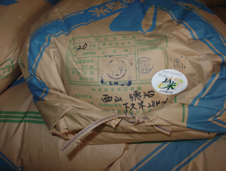 |
|
Note, though, two things. One, only the top two are commonly used. In fact, I only recently heard of a brewer speak of B and C fields, and know that there are others who do not use that nomenclature at all. It is not law nor obligatory. And two, even the “Special A” and “A” designations are based on agreements amongst the farmers. While they take practical and legal measures to protect and promote this system, it is not the law nor official in any other sense. Also, the fact that the system is recognized at all is proof of the quality of the rice that comes from that region. If the rice were not that good, everyone would just ignore them.
This ranking of rice paddies is another rabbit hole, albeit it a very interesting one. You can read more about that system, called the “muramaiseido,” here if you like.
One more thing to note: while the above ranking of fields is an unofficial system, the inspection of rice is a very official and very regulated system. There are concrete, objective points that are observed and recorded, and they are more or less the same for every inspector everywhere.
So we have four grades of fields, and six grades of rice. That gives a total of 24 possible grades of rice. However, most of them we will just never see.
If the ranking of the field is listed on the label, we only really see “Special A” or “A” on a label. No one will write “B” or “C” for all to see. This is for two reasons: one, no one brags about being second or third, and two, the field designation system is only officially recognized inside the “Yamada Nishiki Club,” (my term!) or those that own and till the best fields. No outside of their considers or calls their fields B, and no one outside considers their fields C fields. “That’s a Hyogo thing,” disdained one brewer north of Tokyo in response to my question about his home-grown Yamada.
Also, many that grow their Yamada Nishiki outside of Hyogo are proud of that. And rightfully so! “It’s local, man, and it’s good.” So we often see the region listed on the label, even when it is not Hyogo. My point here is that just because it is not Hyogo-grown does not at all mean it is not great. Hyogo just markets better as a region. But I digress.
Also, there is lots of overlap between these regional rankings and inspected grades. There is not a linear progression across all 24 types. In other words, it is very, very likely that the "special class" rice of a good field outside of Hyogo is better than the “1st class” rice of a Hyogo field, and that the “top special class” of a field in Hyogo but not from one of the “Yamada Nishiki Club” fields is better than lots of the special class from that hallowed region. The permutations of this argument are endless, and I think readers can see the complexities involved.
Paring it all down to what is really important, if you see “Toku A” field designation for Yamada Nishiki, and / or “Tokujo” grade rice listed on the label, you know you have something great in your hands. And bear in mind that there are, if we count 'em, 24 different possibilities about sources for Yamada Nishiki. But just remember it is a great rice, and if it has been used to make the sake before you, it has a head start on many other sake.
Beyond that, absorb what information has been provided, and enjoy it. That’s enough.
|
Sake Brewery Tours in Japan, 2014:
Okayama tour still available!
Here is the latest from Sake Tours :
 |
|
You still have a chance to experience a sake-brewery focused tour to Japan this coming year! Sake Tours will go to Okayama Prefecture, January 27th - 31st.
The Okayama tour combines sake, food, and art with visits to beautiful classic towns.This tour especially highlights sake with four (count 'em!) kura visits as well as cultural activities to which even locals do not have access. Some very memorable experiences you will find only with us are: a session with an Omachi sake rice grower, hands on rice field plowing, a private Kagura dance performance, a private Shiki Hocho knife ritual once performed only for the emperor, a hands-on guinomi sake cup making experience with Bizen artists, observing the art of sword making and more. On the last day, simply relax at the hot springs by the river far away from the city, in the snow.
Remember, this time the Japan Sake and Shochu Makers Association is supporting part of the cost. They invite all sake enthusiasts to really experience Japan through sake with their help. This is a one-time opportunity you cannot miss!
The tour cost is 270,000 JPY per person. With 50,000 JPY support from Japan Sake and Shochu Makers Association, your cost is only 220,000 JPY.
Please visit http://saketours.com for tour information after September 15. Group size is limited to 12.
Send an email to info@saketours.com for more information.
|
 Announcements and Events Announcements and Events
Sake Professional Course in Japan
January 20 to 24, 2014
...
has checked in full!
The 2014 Sake Professional Course in Japan will be held from Monday, January 20 to Friday, January 24, 2014. This is
it - the most comprehensive and intense sake educational program on the planet. Three days of class and tastings, sake pubs and izakaya at night, and two full days of sake brewery visits.
No sake stone remains left unturned!
And, it has checked in full this year. Thanks to those 25 who will be participating. The next course will be held in the US in the spring, but the dates and venue are as of yet undertermined. Please stay tuned for more information soon.
~~~~~~~~~~~~~~~~~~~~
Sake Education Council Website
Please take a moment to check out the website for the Sake Education Council, the organization behind the Certified Sake Professional and Advanced Sake Professional certifications. We plan to grow steadily, strongly and continually, and we will need the support of all those that love sake to do so. Follow us through the "usual suspects" of social media.
Don't forget the archives!
Older editions of this newsletter are archived here.
Really old editions are archived here.
|
 Sake Education Central Sake Education Central
Sake's Hidden Stories and The Sake Notebook are now available for the Kindle, Nook and iBooks!
The Sake Notebook is now available for the Kindle as well as the Nook. And now, it is available for iBooks on iTunes as well!
Sake's Hidden Stories too is now availabe on the Kindle as well as the Nook. And now, it is available for iBooks on iTunes as well!
Both are
less expensive than their original pdf version too. Now is your chance to learn more about sake from your phone or tablet! Check 'em out!
Sake Dictionary App for the iPhone, iPod and iPad
"For 99 cents, this app ROCKS!!"
-a satisfied customer
There you are, perusing a menu, or standing in front of a shelf of great sake, or perhaps reading a sake newsletter… and up pops one of those hairy, pesky sake terms in Japanese. You know you have heard it many times, but dammit, you just cannot remember what it means now…
No problem! Just whip out your iPhone or iPod and fire up your trusty old version of
The Sake Dictionary. In a matter of seconds, you’ll be amongst the cognoscenti once again. But… if only you could pronounce it properly. Now that would really rock!
Done! Just tap on the term and you will hear a clear example of how to pronounce the term in Japanese. Repeat it a couple of times and the term is yours for eternity, to toss about and impress your mates.
What’s more, it’s
less!
Less than what it cost before, much less. Like less than one-seventh less. For a limited time only, the audio-enhanced version of The Sake Dictionary iPhone app is available for a mere $0.99.
|
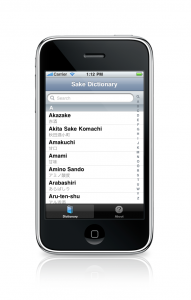 |
|
|
The Sake Dictionary is a concise little package of all the terms you might ever come across when dealing with sake. Almost 200 of them - including sake grades, rice variety names, seasonal sake terms, special varieties, rare types, post-brewing processing words and the myriad terms used in sake production - many of which are not even familiar to the average Japanese person on the street - are listed up here with concise, useful and clear definitions and the written Japanese version as well. And now, with the new audio component, you can listen and learn just how to pronounce those terms properly.
Start to toss around Japanese sake terms like you were raised knowing them! Gain a level of familiarity hitherto unimaginable! Avoid frustrating paralysis when faced with a sake-related purchase!
Get your copy of The Sake Dictionary now and never be confused by sake terms - or how to pronounce them - again.
Get it here: http://itunes.com/apps/sakedictionary
(Note if you have already purchased it, this upgrade to the audio version is free. Just go to iTunes and get it!)
|
Are you not getting this newsletter? I realize that is like asking that
"those not present please raise your hand," but for future reference, should you spontaneously stop receiving this newsletter, please go here and sign up again. Should that not work, please go to www.sake-world.com.
Email newsletter services are very careful not to be considered spam enablers, but the problem is that often very valid email addresses come back bounced as invalid. It is an unavoidable problem. So if you or someone you know is not getting this, or stop(s) receiving it inexplicably, please do take a moment to double check that you are still subscribed.
Sincere apologies for the hassle, mixed with gratitude for reading this newsletter. |
I hope you have found the above information helpful and entertaining. For more information about all things sake, please check out www.sake-world.com. Until next month, warm regards, and enjoy your sake.
Questions and comments should be directed to John Gauntner, at this
email address.
All material Copyright, John Gauntner & Sake World Inc.
Regards,
John Gauntner
Sake World, Inc
 . . 
|
|
